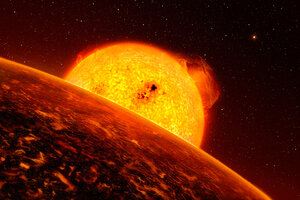Mysterious distant planet 'disappearing before our eyes'
CoRoT-7b is so close to its parent star – and so hot – that scientists think it could be the remnant of an evaporated ‘hot Jupiter.’

This image provided by the European Southern Observatory in September shows an artist's rendition of the first rocky extrasolar planet called CoRoT-7b. According to scientists, the planet is so close to it's sun that its surface temperature is more than 3,600 degrees Fahrenheit, too toasty to sustain life. It circles its star in just 20 hours, zipping around at 466,000 mph. By comparison, Mercury, the planet nearest our sun, completes its solar orbit in 88 days.
ESO/AP/File
Astronomers appear to have caught an exoplanet – a planet orbiting another star – in the middle of a cosmic vanishing act.
The planet, tagged CoRoT-7b, first hit the headlines last September when a team of astronomers confirmed the orb as the smallest exoplanet yet found. Its diameter is roughly 1.7 times that of Earth. Based on its size and mass, its density is similar to Earth's, indicating that it is a rocky Earth-like orb.
But it wasn’t always this small. Scientists estimate that CoRoT-7b initially tipped the cosmic scales at 100 times more mass than Earth and orbited the star at a distance of about 2.3 million miles.
New findings suggest its proximity to its sun gives it a molten-hot surface temperature that is causing the planet to slowly vaporize.
If the astronomers’ calculations are correct, the planet could be the first of a new class of planets, which astronomers have dubbed “evaporated remnant cores.”
CoRoT-7b orbits so close to its parent star – some 1.6 million miles away, compared with 93 million miles for Earth – that its "year" lasts 20.4 Earth hours. That gives it a surface temperature of some 3,600 degrees Fahrenheit on the daylit half. Such searing temperatures translate into a roiling surface of molten rock.
Many of the expolanets found at similar or somewhat larger distances from their suns have been so-called hot Jupiters – slowly roasting gas-giant planets. Having a rocky, Earth-sized planet in a similar orbit raises the question: Could CoRoT-7b be the remains of a vaporized hot Jupiter?
Several previous studies suggested that hot Jupiters underwent a fiery demise. A team led by Brian Jackson, a post-doctoral fellow at NASA's Goddard Spaceflight Institute in Greenbelt, Md., took a close look at CoRoT-7b and concluded that such a process is underway there, too.
In this case, it would be a vaporized hot Saturn, based on the team’s estimates of its initial mass. Its gas vaporized and vanished as it migrated closer to its sun, leaving a rocky core with a lava surface that will ultimately boil away.
Another, more prosaic, answer could be that CoRoT-7b was always rocky, just more massive in the past. Either way "this planet is disappearing before our eyes," Dr. Jackson said in a statement.
He and his colleagues reached their conclusion after running simulations of planet formation on the distant solar system – backwards.
Essentially, as the star toasted the original planet, the planet lost mass. As that happened, the planet's gravitational tug on the star changed in ways that altered the ocean-like tides on the star. Those tidal changes in turn pulled the planet ever closer. But the closer the planet got, the more mass it lost, and the slower this "tidal migration" process changed its orbit.
Jackson shared the team's results this week during a briefing at the American Astronomical Society's winter meeting in Washington.
---
Follow us on Twitter.

